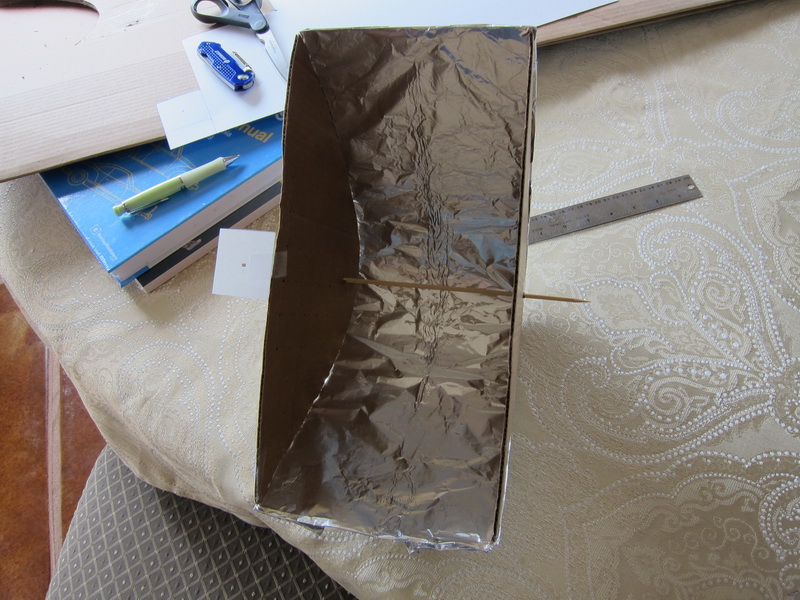Introduction
Solar energy is an important part of our future. Oil, gas, coal and other non-renewable energy sources are becoming more expensive. The population of our planet is growing and we will all still need energy to live.
Our sun produces a lot of energy and will keep producing energy for over 7 billion years! The sunlight hitting the ground at noon in the summer produces about 1000 watts of energy per square meter. This is as much power as a hairdryer, microwave, or small stove produces.
The problem is that when sunlight is not focused, its energy is not easy to use. For example, a hot dog lying on a plate in the sun will collect only 5 watts of energy. With only 5 watts the hotdog won’t get much hotter than a stick lying on the ground.
The solar oven we will making using these instructions will collect about 75 watts of solar energy and focus it on a hotdog for you to eat. 75 watts is about as much power as a light bulb produces. You probably know that a light bulb can get pretty hot. So we should be able to do a good job cooking our hotdogs with 75 watts of solar power.
Be patient, though. Our solar oven is not very efficient, because the aluminum foil is not a perfect reflector, and if the foil is crinkled the solar energy will not focus on the hotdog. If you do your best to keep the foil smooth, your oven will do a good job and cook a nice and tasty hotdog in about 20-30 minutes!
Materials
- 2 pieces of cardboard larger than 14″ x 8″ each
- 1 piece of poster board measuring at least 23″x7″ (this will be cut to become the reflector)
- Parabola Stencil (download HERE)
- aluminum foil
- scotch tape
- scissors or something to cut the cardboard and poster board with
- ruler
- hotdogs and buns
- 12″ wooden skewer
Building the Oven
Making the Frame
First we need to cut out some cardboard to make the frame for our oven. We have provided you with special templates to help you cut out the cardboard (shown in Figure 1).
Notice that the template is not a half circle, but instead it is a special curve called a parabola. Most satellite dishes are shaped like a parabola. A parabola is special because when light shines from far away and in a straight line (like light from the sun) toward the parabola, the surface of the parabola will focus that light (solar energy) to the focal point. The focal point is the big dot on your template.
After you cut out your cardboard it is important to poke a hole in it, right in the middle of the big dot. This is where your hotdog will go. Remember, we want the light (solar energy) to focus on the hotdog so the hotdog needs to be at the focal point. You can see some examples of the cut out parabolas in Figure 2.
Also, put a mark on your cardboard right at the center of the top of the parabola. We will use this to help us aim our ovens at the sun later when we start cooking! Don’t forget we need two pieces of cardboard cut with the parabolic shape.
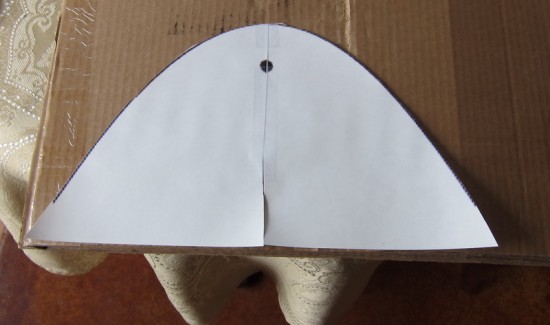
Figure 1
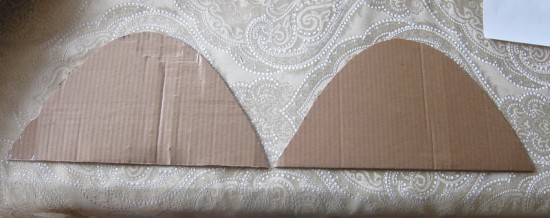
Figure 2
Making the Reflector
Next we need to make a reflector. The reflector is a piece of poster board covered with aluminum foil. It is easy to make. Using a ruler and scissors cut out a square piece of poster board which is 23” long and 7” wide like in Figures 3 and 4.
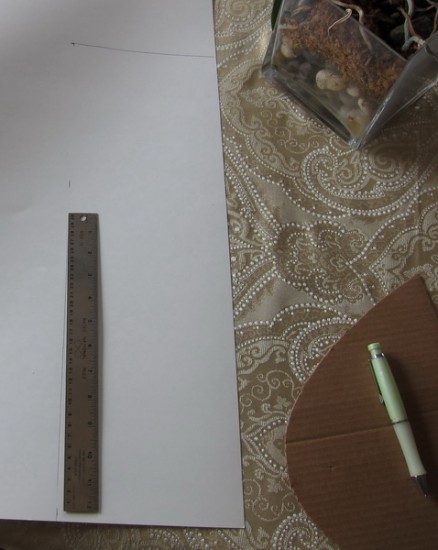
Figure 3
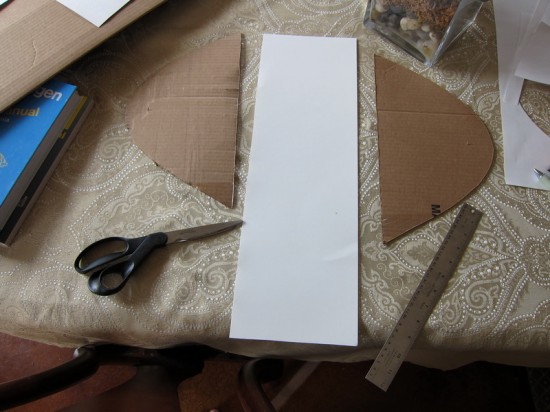
Figure 4
Now, take a piece of aluminum foil that is a little bigger than the poster board so you can fold it over the poster board like in Figure 5. This part is pretty important! Aluminum foil has two sides, and one side is shinier than the other. Be sure to put the shiny side of the aluminum foil facing out. This will make a better reflector. Also, try very hard to keep the aluminum foil flat and un-crinkled. The flatter it is the better oven you will have! Tape the folded over aluminum foil to the poster board so it won’t come off. When you are done you should have a reflector that looks like Figure 6.
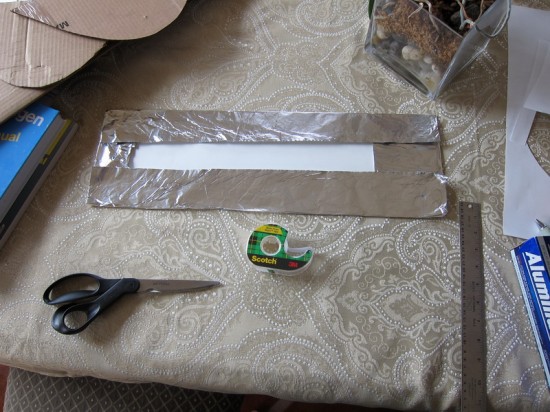
Figure 5
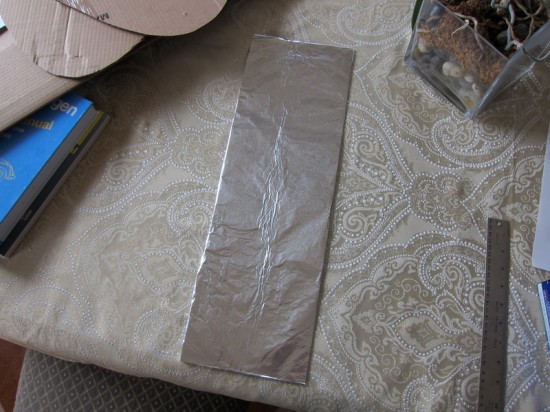
Figure 6
Assembling the Oven
The next step is a little tricky! We have to tape the reflector to the cardboard parabola we just made. With the shiny side of the reflector facing up, tape the curved part of the cardboard to the edge of the reflector. It is hard to describe with words so take a look at Figures 7 and 8. Make sure to use some tape to keep the reflector attached to the cardboard. Don’t be afraid to ask for help with this part if you don’t understand.
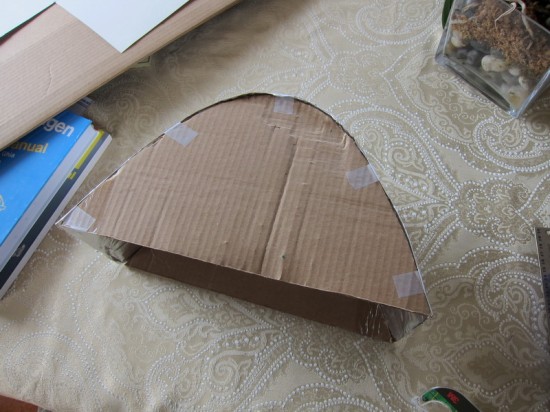
Figure 7
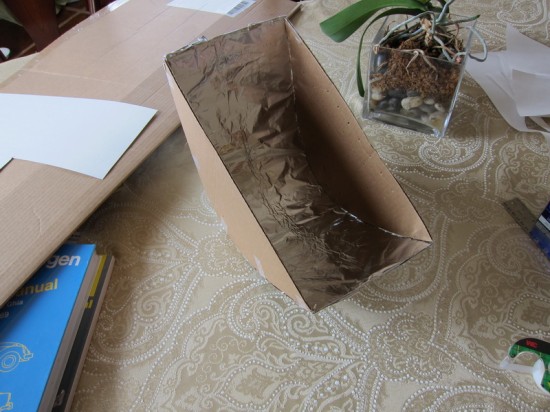
Figure 8
Finishing Up
Congratulations! You are almost done.
Remember the small hole we put in the cardboard at the focal point of the parabola? Now it is time put push the wooden skewer through that small hole. Be careful though. We have to get a hotdog on here too. Push the skewer through the first hole in your oven.. Be careful that the tape on the reflector doesn’t come undone. You need to be gentle. The oven is delicate!
Now, get your hotdog! After the skewer is pushed through the first hole you will need to put the hot dog on the skewer and then push the skewer through the second hole. This part is also a little tricky so don’t be afraid to get some help. You can see the oven with a skewer in it in Figure 9. (Sorry; there’s no hotdog in the picture.)
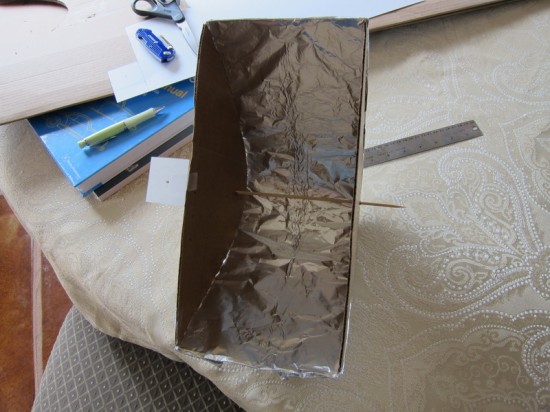
Figure 9
Cooking
There are a couple more tricks to have a toasty hotdog to eat. When we are cooking it is important to keep the cooker aimed properly at the sun. We can use the shadows of the skewer, and the shadow of the oven sides to align things properly. The shadow of the skewer should fall on the center of the oven. Do you remember the mark you put on the center of the hump in the cardboard? This mark tells us where the center of the oven is. When the shadow of the skewer is lined up with the mark at the center of the parabola hump, then the oven is aimed right at the sun.
There is another direction we have to make sure is aimed at the sun. The oven sides should not make a shadow. If there is a shadow from the sides of the oven (the cardboard sides) then the oven is not aimed quite right.
Use a rock or some pieces of wood to help hold the oven in place. You should check the oven every 5 or 10 minutes to make sure it is still aimed right. Remember, the sun is always moving so you may need to correct the aim of your oven several times.
When little beads or bubbles of juice start coming out of the hotdog, the solar energy has made it very hot and you are almost done cooking. The longer you wait, the better it will taste so be patient! But be very careful not to burn yourself. Don’t touch the hotdog with your bare hands or take a bite out of it until it has cooled down a little! Remember, focusing the solar energy cooked the hotdog with 75 watts. That makes it a lot hotter than if we had just placed it on the ground, where it would have only received 5 watts of power. You can see what a difference we can make in our energy supply if we know how to collect and use solar energy!
I hope you had fun and enjoy your treat. Take this solar oven home and show your family, parents, brothers, or sisters. Tell everyone how much fun solar energy is and how important it is for our future!
Dr. Patrick Marcus
Marcus Engineering, LLC.
About Patrick Marcus
Dr. Patrick Marcus is the President of Marcus Engineering, LLC and a principal of Apparently Connected, LLC. Dr. Marcus has extensive background in electronics design, industrial automation, design for manufacturing. Dr. Marcus has founded and run several successful companies in technology and high reliability industrial manufacturing.

